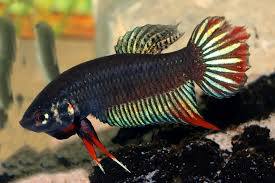Betta Siamorientalis Care, Tank Setup, Breeding

credit: Seriouslyfish.com
Betta fish enthusiasts often focus on the dazzling, long-finned Betta splendens, the common variety found in most pet stores. However, the world of Betta fish is vast, and one particularly fascinating species is the Betta siamorientalis. This wild betta offers something unique – a glimpse into the natural beauty and behaviors of the Betta genus.
Siamorientalis
Betta siamorientalis is a wild betta species native to Thailand and Vietnam, primarily found in slow-moving streams, rice paddies, and peat swamps. They are part of the Betta splendens complex, closely related to Betta imbellis and Betta smaragdina, and share similar characteristics with these species.
Physical Characteristics
-
Finnage: Unlike selectively bred bettas, Betta siamorientalis has short, compact fins rather than long flowing ones.
-
Coloration: Their natural coloration includes subtle shades of green, blue, and red, often displaying an iridescent sheen.
-
Size: Typically smaller than domesticated bettas, they reach about 5–6 cm (2 inches) in length.
Behavior and Habitat
-
Bubble-Nesting: Males construct bubble nests at the water’s surface to protect their fertilized eggs, a common trait in many betta species.
-
Aggression Level: Generally less aggressive than domesticated Betta splendens, but still territorial, especially during breeding.
-
Water Conditions: Prefer soft, acidic water (pH around 5.5–6.5), with temperatures between 24-28°C (75-82°F).
Care in Captivity
-
Tank Setup: A well-planted tank with leaf litter, driftwood, and hiding spots mimics their natural environment.
-
Diet: They are carnivorous and thrive on a diet of live or frozen foods like daphnia, bloodworms, and mosquito larvae.
-
Tankmates: Best kept in species-only setups or with peaceful, non-competing fish due to their territorial nature.
Setting Up a Betta Siamorientalis Paradise
- Tank Size: 5 gallons is recommended for a single Betta siamorientalis. However, a larger tank (10 gallons or more) provides additional swimming space and a more stable environment.
- Filtration: Choose a gentle filter like a sponge filter. Wild bettas prefer slow-moving water.
- Heater: This species thrives in warm water between 75-82°F (24 and 28°C). Install a reliable aquarium heater to maintain these temperatures.
- Décor and Plants: Simulate their natural environment with plenty of live or silk plants. Include driftwood or caves for hiding spots and security. Indian almond leaves provide additional benefits, releasing tannins that mimic their native habitat.
- Tank Mates: Male Betta siamorientalis should generally be kept alone. Females can sometimes co-exist in a larger, heavily planted tank, but close monitoring is necessary. Even females might show aggression toward each other.
Feeding Your Betta Siamorientalis
Betta Siamorientalis are carnivores, and that is why we have a great article on the best foods to feed Siamorientalis. Provide them with a diverse diet to ensure optimal health:
- Live Foods: Their favorites include bloodworms, daphnia, brine shrimp, and mosquito larvae.
- Frozen Foods: A good alternative to live foods, these include frozen bloodworms and brine shrimp.
- Pellets: Choose high-quality betta pellets formulated with minimal fillers. Offer them occasionally to add variety.
Water Conditions for Optimal Health
Betta siamorientalis can be slightly more sensitive to water parameters than selectively-bred bettas. Pay attention to these factors:
- pH: Aim for a pH between 6.0 and 7.5.
- Hardness: Soft or moderately hard water is preferred (GH 5-12, KH 0-8).
- Ammonia and Nitrites: Maintain a zero level for both ammonia and nitrites.
- Nitrates: Keep nitrates below 20 ppm with regular water changes.
Additional Considerations
- Availability and Sourcing: Betta siamorientalis are rarer in the aquarium trade than Betta splendens. You’ll likely need to find a specialized breeder or online retailer concentrating on wild betta species. Always ensure you are sourcing your fish from a reputable source that prioritizes the health of the animals.
- Water Changes: Betta siamorientalis benefit from regular partial water changes (25-50% weekly) to maintain pristine water conditions.
- Jumping: Like other bettas, Betta siamorientalis are excellent jumpers. Securely lid your tank to prevent escapes.
- Tank Cover: Provide floating plants or driftwood that break the surface for resting areas near atmospheric air access.
Breeding Betta siamorientalis
Breeding Betta siamorientalis offers a fascinating but more advanced challenge for aquarists. Unlike the relatively simple process with some Betta splendens, breeding this wild Betta requires dedication and meticulous preparation.Here’s an overview:
- Separate Breeding Tank: Set up a dedicated breeding tank (around 5-10 gallons) with a gentle filter, heater, and plenty of hiding spots for the female.
- Conditioning the Pair: Feed the male and female high-quality live foods for several weeks prior to breeding to promote good health and egg production.
- Introductions and Courtship: Carefully introduce the pair into the breeding tank. Observe their behaviors. The male will build a bubble nest and display elaborate courtship dances to attract the female.
- Spawning: If receptive, the female will develop vertical stripes and join the male under his nest. During spawning, eggs are released and fertilized, and the male carefully collects them in his bubble nest.
- Post-Spawning Care: Remove the female after spawning. The male will usually nest and fiercely guard the eggs. He will not eat during this period.
- Fry Care: Once hatched, tiny fry need specialized foods like infusoria or microworms. As they grow, gradually transition them to larger foods.
Important Notes:
- Breeding any betta can be unpredictable. Sometimes pairs may not be compatible.
- Fry care for Betta siamorientalis can be demanding. Be prepared to raise live cultures of very small foods.
- Thorough research is crucial before attempting to breed Betta siamorientalis. For guidance, connect with experienced breeders or online communities specializing in wild bettas. You can also learn all about betta fish eggs and identifying them here.

